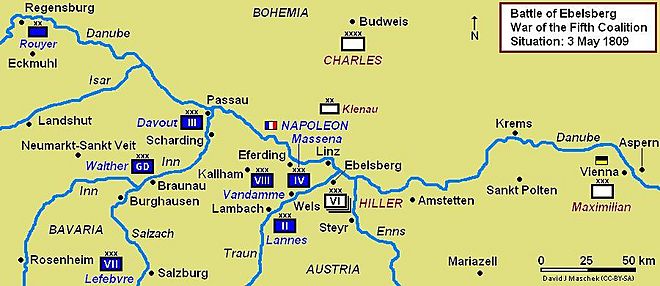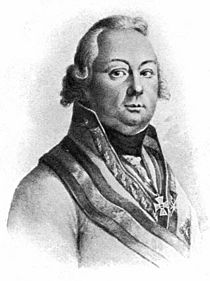Battle of Linz-Urfahr facts for kids
Quick facts for kids Battle of Linz-Urfahr |
|||||||
|---|---|---|---|---|---|---|---|
| Part of the War of the Fifth Coalition | |||||||
|
|||||||
| Belligerents | |||||||
| Commanders and leaders | |||||||
| Strength | |||||||
| 10,000–18,000 | 15,000–20,000 | ||||||
| Casualties and losses | |||||||
| 391 | 883, 4 guns–891, 6 guns | ||||||
The Battle of Linz-Urfahr took place on May 17, 1809. It was a fight between soldiers from the Austrian Empire and troops allied with Napoleon Bonaparte. These allies were from the Kingdom of Württemberg and the Kingdom of Saxony.
The battle happened during the War of the Fifth Coalition, which was part of the larger Napoleonic Wars. Austrian forces, led by General Johann Kollowrat, attacked a fortified area. This area was a bridgehead on the north bank of the Danube River, across from the city of Linz.
The bridgehead was defended by Württemberg soldiers under General Dominique Vandamme. As the fighting began, Saxon troops, led by Marshal Jean-Baptiste Bernadotte, arrived to help the defenders. Seeing these reinforcements, General Kollowrat decided to retreat. Napoleon's German allies then chased after the retreating Austrians. Urfahr is now a part of modern Linz, located on the Danube's north bank.
Contents
Why the Battle Happened
After a defeat at the Battle of Eckmühl in April 1809, the main Austrian army, led by Archduke Charles, Duke of Teschen, moved north of the Danube. Charles wanted to protect Bohemia and also threaten Napoleon's supply lines. These supply lines stretched along the Danube valley.
Napoleon, on the other hand, decided to push forward on the south bank of the Danube. His goal was to reach Vienna, the capital of Austria. He ordered his allies, including the Saxon army, to join him.
Setting the Stage for Conflict
Archduke Charles was worried that Bohemia might be attacked. So, he sent General Kollowrat and his III Army Corps to defend the area. Kollowrat's forces included regular soldiers and local defense units called landwehr.
Meanwhile, Napoleon's army was moving quickly towards Vienna. They fought hard at the Battle of Ebelsberg on May 3. Vienna fell to the French on May 13.
On May 4, General Vandamme and his Württemberg troops reached Linz. They found an Austrian force defending the north bank of the Danube. Vandamme quickly set up his cannons and bombarded the Austrians. His soldiers then crossed the river in boats and attacked. The poorly trained Austrian defenders were quickly defeated.
Archduke Charles, still with his main army, ordered Kollowrat to move towards Linz. Kollowrat's mission was to threaten the French supply routes. This set the stage for the battle at the Linz bridgehead.
Who Fought: Allied Forces
Marshal Bernadotte was in charge of Napoleon's German allies. The main force was the 12,000-strong VIII Corps from Württemberg, led by General Vandamme. This corps had infantry (foot soldiers) and cavalry (horse soldiers).
The Württemberg infantry was organized into brigades. These included regiments like the Crown Prince and Duke Wilhelm Line Infantry. They also had light infantry units called Fusilier and Jäger battalions.
The Württemberg cavalry included Chevau-léger (light cavalry) and Jäger zu Pferde (mounted riflemen) regiments. They also had artillery with 22 cannons, including 6-pound guns and 7-inch howitzers.
Only a part of the Saxon IX Corps, about 6,000 soldiers, joined the battle. These were from General von Zeschwitz's 1st Division. They included Grenadier and Line Infantry battalions, as well as cavalry like Hussars and Chevau-léger.
Who Fought: Austrian Forces
General Kollowrat's III Army Corps was divided into three main groups for the attack.
- One group, led by General Hannibal Sommariva, attacked from one side of the bridgehead. It included infantry regiments, Grenz Infantry (border troops), Jäger battalions, and Landwehr units. They also had Uhlan (lancer) cavalry and 12 cannons.
- Another group, led by General Josef Philipp Vukassovich, attacked the center. This force had more infantry regiments, another Grenz Infantry battalion, and a Jäger battalion. They also had cavalry, including Uhlans and Hussars, and 24 cannons.
- A third group, under General Franz Xaver Saint-Julien, made a fake attack towards Mauthausen. This was meant to distract the defenders. Only a small part of this force was actually involved in the fighting. Kollowrat also kept a strong reserve force ready.
The Battle Unfolds
The Austrian attack began at 2:00 PM on May 17. However, Kollowrat soon learned that Bernadotte's Saxon troops had arrived in Linz. Bernadotte had reached Linz that morning and quickly moved his soldiers into the bridgehead.
The Saxon troops attacked the Austrian column led by Vukassovich, pushing them back. Then, they turned their attention to Sommariva's forces on the other side and also defeated them.
A key moment in the battle was a successful charge by the allied cavalry. Württemberg and Saxon cavalry units charged an Austrian artillery battery on Pfennigberg hill. They managed to overrun the battery and capture six cannons. The Württemberg Jägers claimed four cannons, and the Saxon Hussars took the other two.
Historians estimate that Bernadotte had about 10,000 to 18,000 allied troops. Kollowrat commanded about 15,000 to 20,000 Austrians.
What Happened Next
The battle ended with a victory for Napoleon's German allies.
- The Württemberg forces lost 35 killed, 228 wounded, and 40 missing, totaling 303 casualties.
- The Saxon forces had 7 killed, 74 wounded, and 7 captured, totaling 88 casualties.
- The Austrian forces suffered more losses: 49 killed, 263 wounded, 455 captured, and 124 missing, for a total of 891 casualties. They also lost six cannons and two ammunition wagons.
After this defeat, General Kollowrat's corps retreated. They first went to Gallneukirchen and then further north to Freistadt. Archduke Charles did not call Kollowrat's corps back to the main army in time. Because of this, Kollowrat's troops missed the important Battle of Aspern-Essling that happened a few days later.
Later in May, Archduke Charles finally ordered Kollowrat's corps to rejoin the main army. Napoleon also ordered improvements to the defenses at the Linz bridgehead to keep his supply lines safe.




